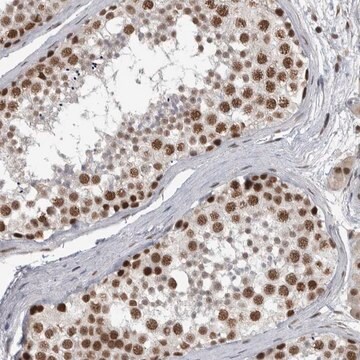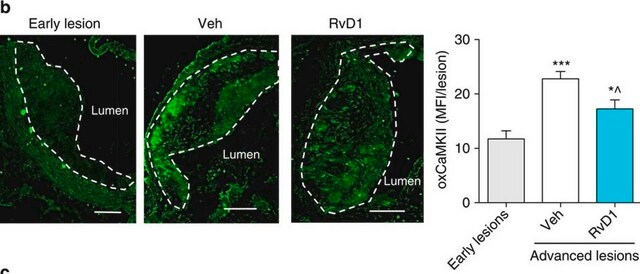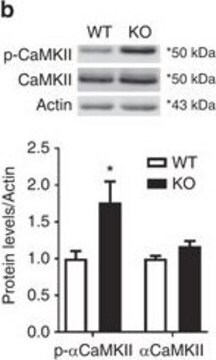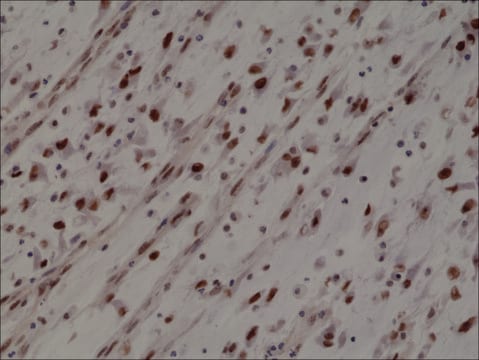General description
MUC18 antigen (CD146), a member of the immuoglobulin superfamily, is an intrinsic membrane glycoprotein of 110-120 kDa found on the surface of endothelial cells, bone marrow fibroblasts and various melanomas. MUC18 has been used as a marker of tumor progression in human melanoma because expression in those tumors correlates strongly with poor prognosis and the development of metastic disease. In addition, a number of human T, B and myeloid leukemic cell lines seem to express MUC18. The close structural relationship with N-CAM and related molecules suggests that MUC18 may be also a developmentally regulated cell adhesion molecule (Melanoma adhesion molecule or MCAM).
Specificity
Detects circulating endothelial cells in human. Expected to cross-react with dog & mouse.
P1H12 reacts specifically with CD146 {MCAM, MUC18}. In blood and marrow P1H12 reacts only with endothelial cells, and has been used to detect circulating endothelial cells in human, dogs and mouse samples. It positively stains normal, primary HUVEC and MVEC cultures and the endothelial cells of all vessels in normal frozen sections of human skin, intestine, ovary tonsil, lymph node, lung, and kidney. It does not stain carcinoma cell lines HT-29 and COLO205, and M21, the T cell lines Jurkat and HuT78, fibroblasts, HL-60 or CHO cells, or EBV-transformed B cell lines, although it expected that CD146 expression is present in many tumor lines. P1H12 does not stain normal monocytes, granulocytes, red cells, platelets, T cells or B cells from marrow or peripheral blood; nor does it detect marrow megakaryocytes or the megakaryoblast line HU3. The peripheral blood cells that do stain with P1H12 also are positive for both von Willebrand Factor (vWF) and thrombomodulin (the combined expression of which is limited to endothelium), and they stain for flt and flk. In recent testing, melanoma A2058, SKMEL.3 and A375.S2 are positive, while murine melanoma M3 is negative. One smooth muscle line (HISM) was positive and one negative (TIGHA-VSMC). Human blood lymphoctes are negative with or without prior stimulation.
Immunogen
Immunization of mice with HUVEC
Application
Detect MCAM using this Anti-MCAM Antibody, clone P1H12, FITC conjugated validated for use in FC.
Immunocytochemistry: 1-10 μg/mL. Works best on EDTA or Trypsin lifted endothelial cells.
Immunohistochemistry: 1-10 μg/mL. 4% PFA for 30min RT or <2hrs @4°C. Block w/ 1%BSA/0.2%tween20/PBC for 30min. Works well in frozen tissue; fixed or unfixed.
Facs Analysis: 1-10 μg/mL
Optimal working dilutions and protocols must be determined by end user.
Research Category
Cell Structure
Research Sub Category
Adhesion (CAMs)
Physical form
Protein A purified
Purified immunoglobulin. Liquid in 0.02M PBS, 0.25M NaCl, pH=7.6, 15 mg/nL BSA containing 0.1% sodium azide as a preservative.
Storage and Stability
Maintain for 1 year at 2–8°C from date of shipment. For maximum recovery of product, centrifuge the original vial after thawing and prior to removing the cap.
Analysis Note
Control
HUVEC cells
Other Notes
Concentration: Please refer to the Certificate of Analysis for the lot-specific concentration.
Legal Information
CHEMICON is a registered trademark of Merck KGaA, Darmstadt, Germany
Disclaimer
Unless otherwise stated in our catalog or other company documentation accompanying the product(s), our products are intended for research use only and are not to be used for any other purpose, which includes but is not limited to, unauthorized commercial uses, in vitro diagnostic uses, ex vivo or in vivo therapeutic uses or any type of consumption or application to humans or animals.









